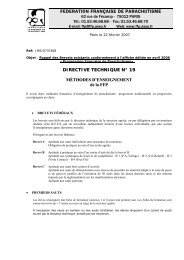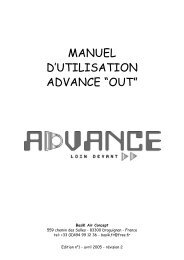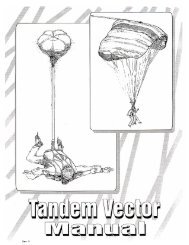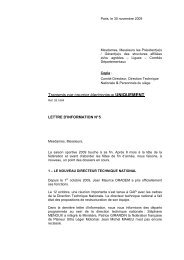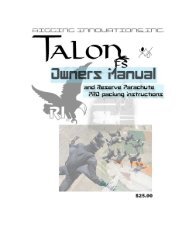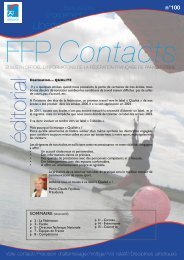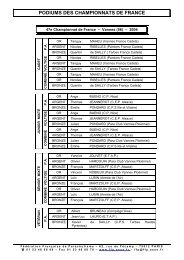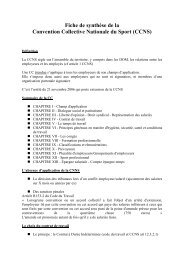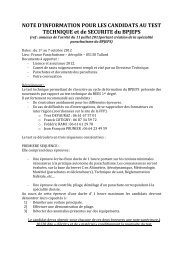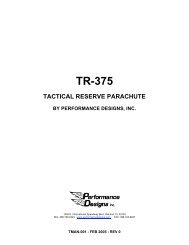tandem vector owner's manual
tandem vector owner's manual
tandem vector owner's manual
You also want an ePaper? Increase the reach of your titles
YUMPU automatically turns print PDFs into web optimized ePapers that Google loves.
SIGMA TANDEM SYSTEM OWNER’S MANUAL<br />
The advantages of this system are obvious. The spherical shape of the ripcord handles, and their<br />
method of attachment, makes snagging highly unlikely. If dislodged, they automatically return to<br />
position, so no more searching for “floating” ripcords. And the unique “Safety Pin,” connected to<br />
the drogue bridle, makes it virtually impossible for a snagged ripcord handle to cause an accidental<br />
container opening. And let’s not forget, you no longer have to waste time and effort stowing the<br />
handles after opening, or searching for them at packing time.<br />
Because this system is new (The first production rigs went into service Summer 2000), we don’t yet know how long the<br />
recoil ripcord system will last under actual field conditions. Although bench tests show that the ripcord system can<br />
last for over 1,000 jumps, you should inspect the whole system often for signs of wear.<br />
Look for wear at the junction of the Spectra ripcords and the handles, and around the pin area. The Spectra is 1,000<br />
lbs. strong, and the force required to pull the pin is less than 10 lbs. That’s over a 100 to 1 safety margin, so a small<br />
amount of fraying should not be cause for alarm. Besides, the ripcord system is designed to be redundant. If one side<br />
were to break or jam for any reason, the other side is still fully functional.<br />
Also notice if the recoil system is doing its job properly. With the rig packed, each ripcord should snap back into place<br />
when pulled a few inches and released. But please realize, if you pull and release each ripcord handle several times<br />
before each jump, you will shorten the life of the system by a factor of three. Inspect, but don’t play with the system<br />
incessantly if you want maximum life from your ripcords.<br />
UNDERSTANDING THE SIGMA SKYHOOK RSL COLLINS’ LANYARD<br />
The Collins’ lanyard was designed to prevent a main-reserve entanglement, by releasing the left (non-RSL side) main<br />
riser, in the event that the right (RSL side) main riser breaks or prematurely releases by itself, for any reason. On the<br />
Sigma, it is integrated into the RSL with no external lanyard. This is accomplished by threading the left riser 3-ring<br />
release cable through a loop in the reserve static line (RSL). As the right riser leaves, the RSL automatically pulls the<br />
left cutaway cable as it pulls the reserve pin, yielding an almost simultanious breakaway and clean reserve deployment.<br />
A standard RSL does one thing. It pulls the reserve ripcord pin automatically after a breakaway. The Skyhook RSL does<br />
this, and then goes two steps further.<br />
A. It automatically releases the Left (non-RSL) riser, if the right (RSL) riser releases prematurely for any reason (Collins.<br />
Lanyard). (You wouldn.t want your reserve container opened with one riser still attached, would you?)<br />
B. It then uses your departing main canopy as a super .pilot chute. to get your reserve to line stretch faster<br />
than ever before. Breakaway, to canopy-out-of-bag times are between ½ and ¾ of a second, depending on the<br />
size of your reserve canopy. This is up to three times faster than a pilot chute can do it alone.<br />
If you have a main total malfunction, or your AAD fires, the Skyhook Lanyard automatically releases, and<br />
therefore does nothing to hinder normal reserve deployment.<br />
Page 12:X Section 2: Equipment • Chapter 1 - Description 11301 - 00.00.0000



